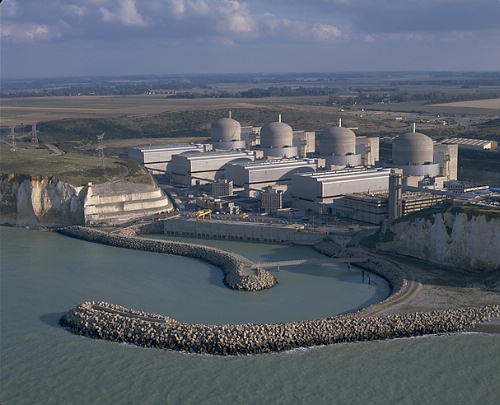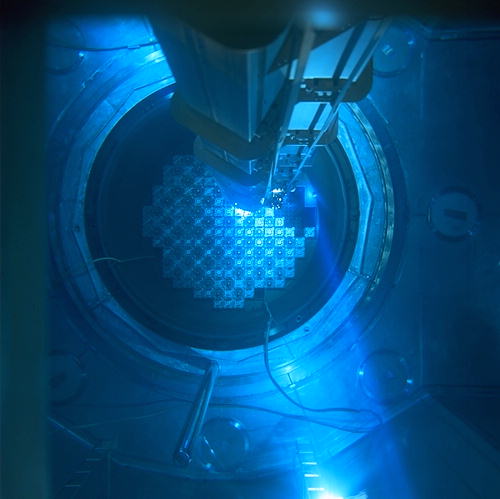The most widespread type of reactor …
Pressurised water reactors (PWR) are by far the most common type in use today, making up 100% of France’s nuclear reactors, 80% of Europe’s installations and 60% of those found in the world. In 1995, they produced altogether a total electrical power of 221.6 Gigawatts.

Nuclear Power Plant with 4 PWR units
The Paluel powerplant in Haute-Normandie consists of four pressurised water reactors or PWRs, by far the most common type of reactor in use today. Each reactor has an electric power of 1.3 million kilowatts (GW). Nuclear Power plants are expensive. especially because of safety requirements. To be competitive such facilities must be large. For instance the 4 units of the Paluel power plant shown above, for instance, are able to satisfy the energy demands of 5 millions peoples in a technologically advanced country such as France.
© LA MEDIATHEQUE EDF / MARC MORCEAU (1990)
PWRs belong to the second generation of reactors, which took precedence over early reactors powered by natural uranium fuel. These second-generation reactors are of an American design. They were developed in and after the 1970s, when moderately enriched uranium fuels became available for civilian purposes. In France PWRs were built mainly in the 80’s by Framatome
The fuel moderately enriched (3 to 5%) in fissile uranium-235 can be associated with ordinary water to slow down neutrons. This water also cools the core of the reactor. Kept under high pressure (155 atm) and not allowed to boil, the primary water passes through a heat exchanger where it transfers its heat to a second loop of water at a lower pressure. This secondary water transforms into steam, then sets off giant turbines whose motion produces electricity.
The secondary steam that loses it pressure in the turbine and cools down is not in contact with radioactive elements. It can be recycled after having been condensed. The plume of steam escaping from the tower of a nuclear power plant comes from a third loop of tertiary water that cools the condenser. To be released into the environment, a radioactive product must pass through the zircaloy shell of the fuel rod, from primary water to secondary water, then secondary water to tertiary water. As a result, the PWRs are the cleanest of second-generation reactors.
The safety provided by these multiple barriers comes at the additional cost of the complexity of the two loops heat exchangers.
The pressurized primary water has the dual role of moderator and coolant. This provides the reactor with an intrinsic natural safety. If, for some reason, the water disappears after a burst pipe, the heat is no more evacuated. But fortunately, since water plays the role of a moderator, neutrons are no more slowed down. The chain reaction stops and with it the release of nuclear energy. Stopping the release of energy limits the severity of the accident.

Loading fuel in the reactor core
Rare insignt of the fresh nuclear fuel loaded in the core of a reactor at the Civaux nuclear power plant in french Poitou-Charentes. The lid of the tank was opened, and one can see at the bottom the mosaic of fuel assemblies already in place, while a robot introduces a new assembly. All handling are done under water.
© LA MEDIATHEQUE EDF / CLAUDE PAUQUET
Nuclear engineers design reactors to operate under normal conditions at a carefully-chosen operating point, a point of equilibrium : the reactor is designed in such a way that reactivity decreases if the core temperature increases, and inversely if it decreases.
Safety in the advent of an accident is provided by several barriers separating the radioactive materials from the environment: the zirconium cladding separating the fuel from the primary water, the walls of the reactor vessel and heat exchangers, and the power plant external walls. The worst accident occurred with such a reactor was that of Three Mile Island in the United States in 1979. Because of the existence of these barriers, there were no significant fall-out for the population.
Other articles on the subject « Nuclear Reactors »
Reactor Families
A variety of designs : Natural uranium or enriched uranium as fuel There are several industrial t[...]
World nuclear reactors
A development that takes place today in Asia At the beginning of 2014 the number of reactors in o[...]
Generation I reactors
1950-1970: First generation of reactors (50 – 500 MWe) The first generation reactors were i[...]
RBMK reactors
Soviet-era reactors at Chernobyl Cold War and the Iron Curtain led after 1947 to the development [...]
Generation II Reactors
1970-2009: the rise of nuclear energy About 85% of electricity produced worldwide by nuclear powe[...]
PWR Operation
High pressure water to evacuate heat and slow down neutrons The reactor core is the source of ene[...]
Boiling Water Reactors
BWR or Boiling Water Reactors Boiling water reactors or BWR are in operation in the United States[...]
Candu reactors
Canadian reactors using natural uranium and heavy water CANDU is a nuclear reactor brand develope[...]
Nuclear Propulsion
On-board reactors for submarines and aircraft carriers In addition to conventional land-based pow[...]